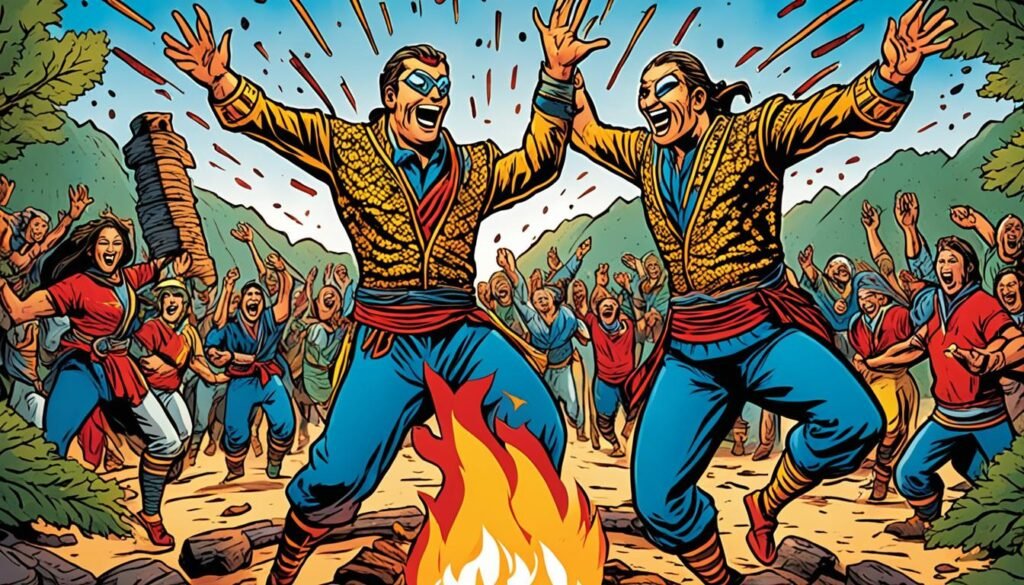In the lush rainforests and hills of the Philippines, the Mandaya people tell stories of a special creature, the primordial eel. They believe this eel has greatly impacted the land and the way it looks. Let’s dive into the story of the Mandaya Primordial Eel and its effect on the Philippines.
The Mandaya mythology is inspired by various cultural traditions such as Hinduism, Islam, Buddhism, and Christianity. This mix has developed into a colorful tapestry of stories and beliefs. It’s a mix that captures the interest of scholars and the public alike.
Key Takeaways
- The Mandaya people of the Philippines have a rich mythology centered around a primordial eel, which they believe significantly influences the country’s geological phenomena.
- Philippine mythologies are rooted in the country’s indigenous folk religions and exhibit influences from various cultural traditions, including Hindu, Muslim, Buddhist, and Christian beliefs.
- Oral literature, such as stories and songs, is a significant source of Philippine mythologies, with narratives evolving and proliferating over time.
- The Mandaya primordial eel is believed to play a crucial role in shaping the geological features and natural landscapes of the Philippines.
- The primordial eel is a powerful symbol within the Mandaya’s cultural beliefs and traditions, representing the interconnectedness of the natural world.
Introduction to Philippine Mythology
Philippine mythology comes from the country’s old folk religions. These were known as Anito and Anitism. They were stories, songs, and traditions passed down by word of mouth and later written down.
Origins and Sources of Philippine Mythologies
Over time, the Philippines was touched by many cultures. Around 200 to 300 CE, Hindu myths came through trade and migration routes. Fast forward to 1300 CE, Muslim traders added their stories to the mix, especially in the south.
Later, in the 1500s, the Spanish brought Ibero-American Christian myths to the islands. This kicked off a long period where these new beliefs fought against the old ones. For three centuries, this was a big part of Philippine history.
Oral and Written Literature as Sources
The stories of Philippine mythology come from two main places. One is oral, or spoken, traditions. The other is written records made by early Spanish and Filipino scholars. Together, these sources help us see the vast and colorful world of Philippine myths.
Overview of Mandaya Mythology
The Mandaya people from the Philippines have rich stories in their Mandaya mythology – all focused on a primordial eel. This eel is key in the Mandaya’s cultural beliefs and views. It helps them see their place in nature.
The Mandaya People and Their Cultural Beliefs
The Mandaya people deeply treasure their myths and beliefs. These tales have been shared for ages. They show the Mandaya’s strong ties with nature.
Significance of the Primordial Eel in Mandaya Folklore
The myth of the primordial eel is crucial in Mandaya mythology. It’s seen as a force that shapes their land. It’s central to the Mandaya’s culture and their bond with nature.

The Primordial Eel and Its Role in Geological Phenomena
In Mandaya mythology, the primordial eel shapes the Philippines’ land. It’s said to cause earthquakes and move the earth’s plates. These actions make the land we see today.
Mythical Accounts of the Eel’s Movements
The Mandaya see the primordial eel as mighty and connected to the earth’s changes. They tell stories of the eel’s powerful movements. These movements cause the earth to shake and lead to special geological formations.
Connections to Geological Events and Formations
Mandaya myths say the eel’s movements shape the land. Its actions lead to the birth of land types. These stories explain how the Philippines’ unique geography came to be.
Mandaya Primordial Eel
Symbolic Representation and Cultural Significance
The Mandaya primordial eel is not just a myth but also key in the Mandaya’s culture. It symbolizes the bond between nature and humans, showing their place in the world. This symbolic significance is seen in their ceremonies and in how they understand the world and its geology.
The Mandaya people hold the primordial eel in high regard, going beyond its tales. As a symbol, it reflects their culture and strong link with their homeland. In Mandaya stories, the eel highlights the harmony between people and nature, emphasizing their holistic view.
In Mandaya rituals, the Mandaya primordial eel is central, acting as a bridge to the spiritual. By honoring the eel in their customs, they keep Mandaya tales alive. They also strengthen the eel’s presence as a powerful symbolic representation in their community.
Geological Phenomena Linked to the Primordial Eel
The Mandaya primordial eel is said to affect many geological events in the Philippines. These include earthquakes, tectonic activities, and how landforms and landscapes form. Stories say the eel’s moves and actions change the earth. This includes making quakes and shaping the land. For the Mandaya people, the eel is a big part of their land’s story.
Earthquakes and Tectonic Activity
Local tales talk about the primordial eel causing earthquakes and earth movements. It is believed that the eel’s big moves shake the tectonic plates. This shaking creates fault lines and lets out seismic energy. Mandaya culture sees these events as signs of the eel’s power over the earth.
Formation of Landforms and Landscapes
The Mandaya say the primordial eel has helped in making the Philippines’ land look the way it does. They believe that as the eel moves, it forms mountains, valleys, and rivers. For them, the eel’s actions have shaped their home’s diverse landscapes.

For the Mandaya, the role of the primordial eel in shaping their land is key. It’s deeply tied to their culture and beliefs. They see it as a force connecting with the earth, crucial to their understanding of nature.
Mythological Explanations for Natural Processes
The Mandaya people see the primordial eel as a key player in geological phenomena and natural systems like water bodies and waterways. They believe the eel’s activities impact rivers, lakes, and other water sources. This shapes the land and influences how these water systems behave. To the Mandaya, the eel’s connection to these natural processes is a central part of their culture and beliefs.
The Eel’s Influence on Water Bodies and Waterways
In Mandaya tales, the primordial eel greatly affects the water bodies and waterways of the Philippines. They say the eel’s movement can change river paths, form new lakes, and tweak the tides and currents. The Mandaya view the eel as a significant force, tying the land to the water in its mythological deeds.
To the Mandaya, this mythological explanation links deeply with their culture and worldview. They explain the formation and workings of water bodies and waterways through the eel’s stories. These stories are a big part of their rich oral and written traditions.
Cultural Practices and Rituals Related to the Primordial Eel
The Mandaya people value the primordial eel in their cultural practices and rituals. They hold ceremonies and make offerings to show respect. This helps keep their folklore and oral traditions alive, sharing the eel’s stories.
Through these cultural practices and rituals, the Mandaya celebrate the eel’s myth. They also feel closer to their land and ancestors. The eel plays a big role in their cultural heritage and connection to nature.
Traditional Ceremonies and Offerings
The Mandaya honor the eel with special traditional ceremonies. They offer gifts like food and incense for the eel’s blessing. This keeps their relationship with nature and the supernatural world balanced.
Preservation of Folklore and Oral Traditions
The primordial eel’s tales are key in the Mandaya’s oral traditions and folklore. By telling these stories, they make sure their culture travels through time. This shows their strong link to their myths, cultural identity, and environment.

Influence on Contemporary Perceptions and Beliefs
The Mandaya primordial eel goes beyond tales and customs. It deeply impacts what the Mandaya people and others in the Philippine culture believe today. This creature’s meaning and its role in nature still shape how the Mandaya see the world. It remains key in their cultural identity and heritage, strongly influencing their lives even now.
The eel has a lasting effect on the Mandaya’s beliefs and cultural views. It shows how powerful Philippine myths are in shaping how people see the environment. The eel’s story helps the Mandaya understand geological events better, showing their deep connection with their land.
For the Mandaya, the eel is more than a story. It’s a symbol of their cultural identity and deeply held beliefs. This story’s influence highlights how important Philippine myths are across different ethnic groups. They affect how people in Philippine society think and view the world today.
Comparison with Other Mythological Creatures and Beings
Similarities and Differences across Philippine Cultures
The Mandaya primordial eel is similar to many creatures in Philippine folklore. Each ethnic group in the Philippines has its unique mythological figures. Yet, there are often similarities and shared qualities. These similarities help us understand the country’s rich cultural heritage by looking at the Mandaya primordial eel alongside other mythological creatures and mythological beings.
The eel and creatures like the Bakunawa both impact natural events. This includes geological and water processes. The Kapre, beings connected to the natural world, also share this trait. Its connection to the land reminds us of the eel’s role in landscape formation.
| Mythological Creature | Ethnic Group | Characteristics | Perceived Influence |
|---|---|---|---|
| Primordial Eel | Mandaya | Powerful, serpentine creature | Geological phenomena, water bodies |
| Bakunawa | Various Filipino cultures | Dragon-like sea goddess | Aquatic processes, natural disasters |
| Kapre | Various Filipino cultures | Towering, hairy tree giants | Natural environments, forests |
The Mandaya view the primordial eel as key to the land’s geological changes. This reverence is similar to the worship of diwata. These nature gods and goddesses are tied to elements like forests and mountains. This similarity highlights the eel’s impact on the land.
Studying the Mandaya eel alongside other creatures deepens our understanding of Filipino folklore. It shows us common themes and cultural viewpoints. These elements make the country’s folklore rich and diverse.
The Significance of Mythology in Understanding Natural Phenomena
The story of the Mandaya primordial eel shows how important mythology is. It helps us understand natural events around us. Mandaya tales give us a look into how the local people view the earth’s development and nature’s ties. These stories give another view on nature’s spiritual and cultural impacts, which differ or support scientific views. Exploring Philippine mythology enriches our understanding of the human-environment link.

Studying the Mandaya primordial eel story deepens our knowledge of indigenous beliefs in natural occurrences. It adds to the broader view of nature, beyond scientific teachings. This journey shows a cultural insight into the natural world.
Preserving and Promoting Indigenous Knowledge
The Mandaya people share stories about a special eel. This eel is key to the Philippines’ indigenous knowledge and culture. Saving these stories is vital for protecting the country’s cultural history. Documenting Mandaya folklore helps us understand their way of looking at the world. It also shows their special bond with nature.
Efforts to Safeguard Cultural Heritage
It’s important to keep the Mandaya’s old stories alive for future families. Doing this makes the Philippines’ culture richer. A book called “The Poetic Power of Place” talks about the need to compare different Austronesian societies. This comparison helps us spread knowledge about their indigenous wisdom.
Importance of Intangible Cultural Heritage
Keeping the Mandaya eel myth and other stories is a way to protect their culture. Sharing these tales lets us learn more about how the Mandaya see the world. It also celebrates their deep connection with nature. This sharing makes the Philippines’ culture more diverse and rich.

